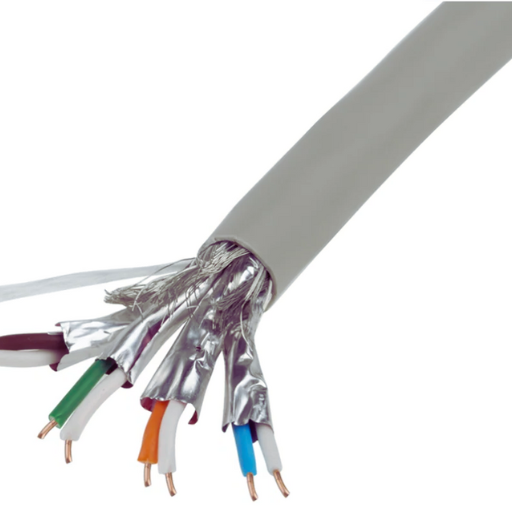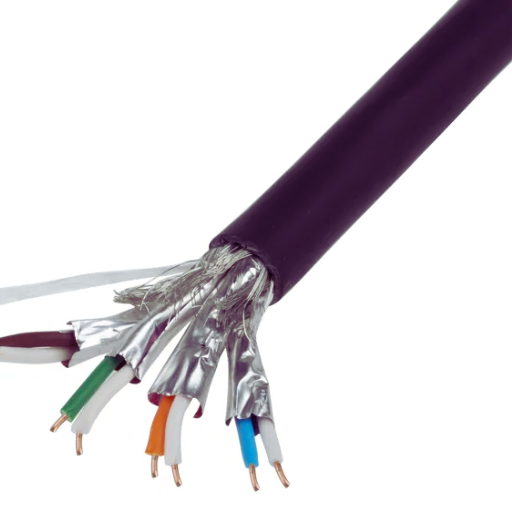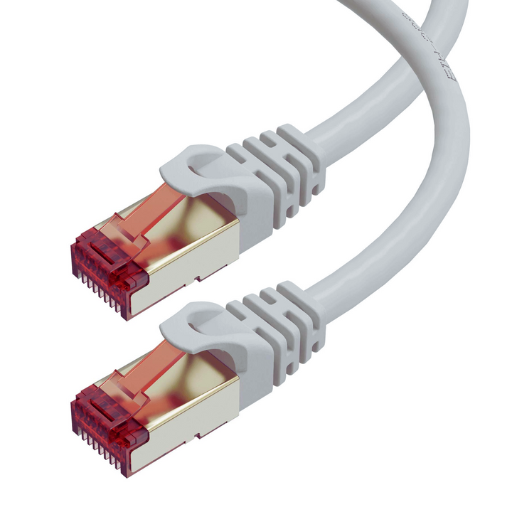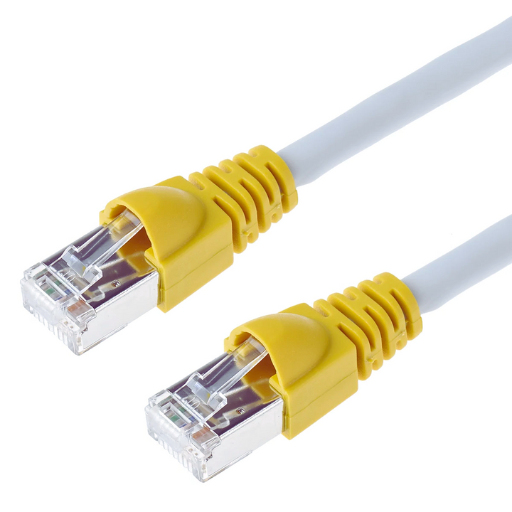Advanced applications are now easily supported by Cat 7 Ethernet cables, which can be seen as a big jump in the field of networking. The cables have been engineered to enable higher frequencies of up to 600 MHz for faster data transmission across longer distances. This article is meant to give you an understanding about Cat 7 Ethernet cables, it goes into details regarding its technical specifications, use cases and benefits as well as installation considerations. By the time you are done reading this guide, you will have all the information you need in order to decide whether or not Cat 7 cables are what you require for your high speed connections.

It is also called Category 7 or Class F cable, is a standard for Ethernet and other networking physical layers with support for high-speed data transfer. These are made with four shielded twisted pairs (S/FTP) and have a bandwidth performance of up to 600 MHz. The purpose of Cat 7 cables is to send information at speeds up to 10 Gbps in distances that reach a maximum of 100 meters. Through the shielding of the pairs and the entire cable, crosstalk and electromagnetic interference (EMI) are reduced thereby making Cat 7 suitable for applications where high performance and reliability capabilities matter.
Cat 7 Ethernet Cable
Cat 8 Ethernet Cable
In conclusion, though appropriate for most domestic as well as light commercial networking deployments; the enhanced performance and shielding properties make cat7 cable suitable for mission critical infrastructures. However, high-performance data centers that require topmost capacities among other features normally use this kind of cables. Each category has specific technical parameters which suit diverse networking needs hence enabling one to make accurate and justifiable choices as per the specific environment requirements.
Internal structure of Ethernet cables, especially pertaining to shielding and the RJ45 connector are critical in determining how well the cable can perform and its ability to resist external interferences.
Shielding
RJ45 Connector
Conclusively, sophisticated internal structures in Ethernet cables using advanced shielding techniques along with quality RJ45 connectors guarantee optimum performance capabilities, reliability standards as well as resistance to EMI or crosstalk which is needed to support modern high-speed networking environments.

SHIELDING
Shielding should be considered most important when choosing a Cat 7 Ethernet cable. The cables are made with improved shielding properties such as a general shield and individual shields on each twisted pair. This tough insulation reduces electromagnetic interference (EMI) and crosstalk, hence enjoy increased signal integrity and reliability especially in environments having much electronic noise. For this purpose, it is essential to go for F/FTP or S/FTP cabling types.
BANDWIDTH
Bandwidth is another vital factor to consider while choosing a Cat 7 cable. In contrast to the older categories such as Cat 5e or Cat6, Cat 7 cables support bandwidths up to 600 MHz. It results from this that the higher throughput of data and higher sensitivity to intensive high magnitude or speed network traffic can be warranted by the larger bandwidth. Because of this excessive use of data in areas like big data centers or heavy multimedia usage cases, there can’t be any substitute for better performance in terms of bandwidth delivered by a cat7 cable.
LENGTH
The length of the Ethernet cable also affects network performance. When speaking about long distances, however, one must remember that although Cat 7 cables can deliver high performance over long distances it is generally recommended to employ the correctly sized cables so as not to suffer losses from signal attenuation and latency. Most installations can tolerate cables up to 100 meters; however, shorter cords usually deliver superior functionality with less attenuation at reduced lengths than their longer counterparts.. Thus an efficient and stable connection would necessitate accuratemeasurements between devices in order help you select appropriate lengths without having too much slack.
In summary, when selecting a Cat 7 Ethernet cable, consider the shielding type to ensure minimal interference, opt for high bandwidth to support fast data rates, and choose an appropriate cable length to maintain signal integrity and performance
Key differences in performance, shielding and application between Cat 7 and Cat 6a as well as Cat 8 Ethernet cables can be observed when compared:
Therefore, choosing between Cat6A, Cat7 or Cat8 Ethernet Cable depends on network specification i.e., bandwidth requirements, susceptibility to interference levels of data transfer capabilities and where it will be installed.
Deciding the worth of investing in a Cat 7 Ethernet cable, rests on your particular network requirements and future plans. Usually for normal home or office networks, Cat 6a cables are good enough. Nevertheless, when you have a setting that necessitates minimal interference and high speed data transmission such as in a data center or industrial type of set up, then go for Cat 7 cables because they are better shielded and support higher bandwidths up to 2000MHz. They also facilitate upgrading of networks soonest possible and are therefore considered to be future proof. Though usually more expensive than cat 6a, it is an investment worth making for specialized environments with improved performance and reduced risk of signal interference.

The design of cat7 Ethernet cables allows them to handle high-speed data transfer rates, making them ideal for locations that need a strong and dependable network. That is, these cables can support data rates of up to 10 Gbps across 100 meters – an excellent provision for HD video streaming, large files transfers and other needs involving data. Furthermore, Cat 7 cables have better shielding features as well as reduced interferences from external impacts which give it a stable and consistent connection.
Though Cat 6a cables also support fast speeds at 10Gbps, cat7 has the advantage of higher bandwidth capacity meaning up to 600MHz compared to what Cat6a offers at only 500MHz. This higher frequency range makes Cat 7 a stronger contender for future-proofing network infrastructure, especially in network environments with high-performance demands such as data centers, video production studios, and industrial setups. Additionally, the extra protection on Cat-7 copper cable’s jacket helps in safeguarding LAN communications against cyber threats that might result in signal degradation.
In conclusion, while initial costs may be higher than category six augmented unshielded twisted pair (Cat6a UTP), the faster speeds offered by cat seven Ethernet cables as well as superior protection measures make it a good option for specialized high-performance networks that are built to last.
The performance of Cat 7 Ethernet cables is enhanced by their 600 MHz bandwidth, which is better than the earlier ones like Cat 6a with a limit of 500 MHz. Above all this, the large volume of data transfers that are required in many application call for these elevated bandwidths. By enhancing shielding, it has been possible to reduce crosstalk and electromagnetic interference, which accounts for the best features of Cat 7 cables. In addition, the stability and robustness of these cables make them ideal for future proofing high-demand network environments. Additionally, its improved bandwidth enables smoother HD streamings, reliable transferring of big files and better performances in sensitive areas such as data centers and advanced industrial applications.
Double-shielded construction is used in designing cat 7 Ethernet cables to make them last longer and be more durable. The overall cable shielding and individual pair shielding (S/FTP) are the two types of double shielding which effectively guard against external electromagnetic interference (EMI) and radiofrequency interference (RFI). This strong design supports excellent performance even in noisy environments, as well as enhancing the cable’s physical toughness to withstand bending, stretching or environmental effects. In this way, Cat 7 cables provide dependable solutions for high-performance networks that maintain a continuous connection at home and in industries.

By following these guidelines, successful installation of Cat 7 Ethernet Cables can be made through which high speed reliable connectivity is obtained in a network.
Significant applications for cat 7 Ethernet cords include:
Using Cat 7s in these ways can significantly improve network performance by providing strong connections and fast data transfer across different devices or applications.
To ensure optimal performance for your Cat 7 Ethernet cables, observe good maintenance and troubleshooting practices. Here are some best practices derived from top industry resources:
Abiding to these maintenance best practices can increase lifespan of a cat-7 ethernet cable while ensuring high levels of network efficiency and reliability is upheld.

Indeed, Cat 7 cables are compatible with previous routers and network devices. They have the same RJ45 plugs that earlier Ethernet standards had, thus able to fit into older systems designed for Cat 5e or Cat 6 cables. However, even though Cat 7 cables can link up to past products physically, the intrinsic advantages of using a cat7 cable such as its broader bandwidth or better shielding will only be felt if both devices—the router and the connected device—have support for higher rates and frequencies. On the other hand, plugging in a cat7 cord to an old-fashioned router is not going to break down a system; nevertheless it will not bring about increased performance capabilities which cat7 cords were intended for.
Typically, Cat 7 Ethernet cables can be of different lengths ranging from about 1 meter (3.3 feet) to 100 meters (328 feet). This variety in size ensures that a user will be able to buy a cable that will suit his needs, whether for a small distance between devices or within the same building.
The length of the cable used affects its performance. For instance, for distances up to 100 meters; this kind of cables support speeds reaching 10 Gbps and frequencies up to 600 MHz. However, with increase in the length of the cables, even very light losses may develop more subtly within them especially when they are located at places where there is much electromagnetic interference (EMI). Therefore, good quality cabling products and installation standards should thus be used to prevent degradation of performance which could occur over longer interconnection spans.
Overall, however robust Cat 7 cables might be in terms of their capability, their optimal usage requires careful considerations for cable length and installation environment.
Cat 7 cables are compatible with Cat 6 and Cat 5 standards, thus a Cat 7 cable can be used in place of Cat 6 or Cat 5 cables without the need for trouble. The connectors on Cat 7 cables usually are RJ45 or GG45 designs, which are designed to be plug compatible with the standard RJ45 connectors used by Cat 6 and Cat 5 cables. However, it is important to remember that whilst these products work fine with lower category networks, their performance will be limited to that of low specification hardware. An example is where you connect a cat seven cable into a cat five network; consequently, the speed of the network would be limited to what a cat five can offer at its best as at one Gbps only. Thus, realizing full performance advantage of Category seven entails having the network infrastructure and devices capable of supporting higher speeds as well as frequencies.

A: It is intended for usage in high-speed internet connections, which provides 10 gigabits per second data transfer rates. With this, modems, routers and network switches can be connected to devices to enable fast and stable online connectivity.
A: Compared to those of cat 6 cables, the cat 7 type has many plus points. They have shielding (SFTP) which reduces crosstalk and electromagnetic interference that could affect them; they support higher frequencies up to 600 MHz as well as having the capability of achieving data transfer rates of up to 10 Gbps in comparison with Cat6’s 1Gbps. Due to this features cat7 cables are used in high speed and reliable internet environments.
A: Indeed it is so because it offers a steady pace web for playing games on Xbox or PS5 machines via networks thereby helping in minimizing latency.
A: For instance, these include individual pair shielding as well as overall shielding for the entire wire pairs thus minimizing electromagnetic interference alongside crosstalk making it clean and steady when transmitting information.
A: Moreover, along distance up to 100 meters without signal degradation—this means that even for specific lengths like 3ft, 100ft or outdoor application, you will still experience high-speed data transmission.
A: Yes, Cat7 Ethernet cables can be used outdoors and more so if you have one that is specifically designed as an outdoor ethernet cable or a direct burial cable. These types of cables are mostly weatherproof with extra coatings to handle different environmental concerns.
A: A Cat7 Ethernet patch cable is a distinct kind of network cable meant for linking devices within short distances such as within a rack or patch panel. It has heavy shielding to prevent any interference and usually comes with RJ45 connectors which are gold plated for better conductivity and reliability in high-speed data transfers.
A: A Cat7 Ethernet cable has a frequency rating of up to 600 MHz, which enables it to support high-speed, high-frequency data transmission. This makes it even better than lower category cables like Cat6, making them very important for gigabit ethernet networks.
A: Yes, cat 7 ethernet cables work on the standard ethernet ports also. They use RJ45 connectors that are normally found in many networking devices and this means using your existing equipment with no problems at all.